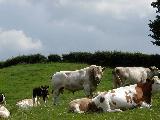
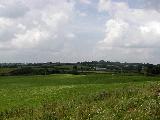
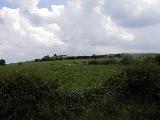

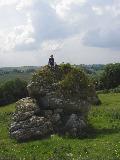 From there, we proceeded to the navelstone of all Ireland, the Aill na Mireann or Stone of Divisions on the side of the hill of Uisneach, referred to as the "Catstone" on the nearby sign and the "Mearing Stone" by Joyce in Finnegans Wake. I photographed it from all four cardinal directions, but show it here only as seen from the north or Ulster side, with Trevor (naturally) on its top.
From there, we proceeded to the navelstone of all Ireland, the Aill na Mireann or Stone of Divisions on the side of the hill of Uisneach, referred to as the "Catstone" on the nearby sign and the "Mearing Stone" by Joyce in Finnegans Wake. I photographed it from all four cardinal directions, but show it here only as seen from the north or Ulster side, with Trevor (naturally) on its top.
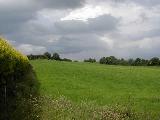 Finally, we proceeded to the hill of Slemain Midi. Just before the battle of Gáirech, Medb's herald Mac Roth reconnoitred the opposing force, King Conchobor's Ulstermen, as they gathered here, troop by troop of three thousand men each; and Mac Roth reported back in a passage that ranks among the great epic catalogs. The following exchange, quoted from Thomas Kinsella's translation of the Táin Bó Cuailnge (London: Oxford UP, 1970, p. 225), shortly precedes this catalog of Ulster forces:
Finally, we proceeded to the hill of Slemain Midi. Just before the battle of Gáirech, Medb's herald Mac Roth reconnoitred the opposing force, King Conchobor's Ulstermen, as they gathered here, troop by troop of three thousand men each; and Mac Roth reported back in a passage that ranks among the great epic catalogs. The following exchange, quoted from Thomas Kinsella's translation of the Táin Bó Cuailnge (London: Oxford UP, 1970, p. 225), shortly precedes this catalog of Ulster forces:
'Let them come,' Ailill said. 'We have warriors to meet them.'
'You'll need them,' Fergus said. 'No one in all Ireland, or the western world from Greece and Scythia westward to the Orkney Islands and the Pillars of Hercules, as far as the tower of Breogan and the Islands of Gades, can withstand the men of Ulster when their fury is roused.'